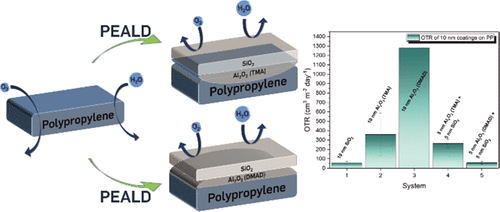当前位置:
X-MOL 学术
›
ACS Appl. Mater. Interfaces
›
论文详情
Our official English website, www.x-mol.net, welcomes your
feedback! (Note: you will need to create a separate account there.)
PEALD of SiO2 and Al2O3 Thin Films on Polypropylene: Investigations of the Film Growth at the Interface, Stress, and Gas Barrier Properties of Dyads
ACS Applied Materials & Interfaces ( IF 8.3 ) Pub Date : 2018-02-19 00:00:00 , DOI: 10.1021/acsami.7b14916 Maximilian Gebhard , Lukas Mai , Lars Banko , Felix Mitschker , Christian Hoppe 1 , Montgomery Jaritz 2 , Dennis Kirchheim 2 , Christoph Zekorn 2 , Teresa de los Arcos 1 , Dario Grochla , Rainer Dahlmann 2 , Guido Grundmeier 1 , Peter Awakowicz , Alfred Ludwig , Anjana Devi
ACS Applied Materials & Interfaces ( IF 8.3 ) Pub Date : 2018-02-19 00:00:00 , DOI: 10.1021/acsami.7b14916 Maximilian Gebhard , Lukas Mai , Lars Banko , Felix Mitschker , Christian Hoppe 1 , Montgomery Jaritz 2 , Dennis Kirchheim 2 , Christoph Zekorn 2 , Teresa de los Arcos 1 , Dario Grochla , Rainer Dahlmann 2 , Guido Grundmeier 1 , Peter Awakowicz , Alfred Ludwig , Anjana Devi
Affiliation

|
A study on the plasma-enhanced atomic layer deposition of amorphous inorganic oxides SiO2 and Al2O3 on polypropylene (PP) was carried out with respect to growth taking place at the interface of the polymer substrate and the thin film employing in situ quartz-crystal microbalance (QCM) experiments. A model layer of spin-coated PP (scPP) was deposited on QCM crystals prior to depositions to allow a transfer of findings from QCM studies to industrially applied PP foil. The influence of precursor choice (trimethylaluminum (TMA) vs [3-(dimethylamino)propyl]-dimethyl aluminum (DMAD)) and of plasma pretreatment on the monitored QCM response was investigated. Furthermore, dyads of SiO2/Al2O3, using different Al precursors for the Al2O3 thin-film deposition, were investigated regarding their barrier performance. Although the growth of SiO2 and Al2O3 from TMA on scPP is significantly hindered if no oxygen plasma pretreatment is applied to the scPP prior to depositions, the DMAD process was found to yield comparable Al2O3 growth directly on scPP similar to that found on a bare QCM crystal. From this, the interface formed between the Al2O3 and the PP substrate is suggested to be different for the two precursors TMA and DMAD due to different growth modes. Furthermore, the residual stress of the thin films influences the barrier properties of SiO2/Al2O3 dyads. Dyads composed of 5 nm Al2O3 (DMAD) + 5 nm SiO2 exhibit an oxygen transmission rate (OTR) of 57.4 cm3 m–2 day–1, which correlates with a barrier improvement factor of 24 against 5 when Al2O3 from TMA is applied.
中文翻译:

聚丙烯上的SiO 2和Al 2 O 3薄膜的PEALD :在双分子膜的界面,应力和气体阻隔性能方面的膜生长研究
针对在原位石英上聚合物基板和薄膜的界面处发生的生长,对聚丙烯(PP)上的非晶态无机氧化物SiO 2和Al 2 O 3进行了等离子体增强的原子层沉积研究。-晶体微量天平(QCM)实验。在沉积之前,将旋涂PP(scPP)的模型层沉积在QCM晶体上,以将发现的结果从QCM研究转移到工业应用的PP箔上。研究了前体选择(三甲基铝(TMA)与[3-(二甲基氨基)丙基]-二甲基铝(DMAD))和血浆预处理对监测的QCM反应的影响。此外,SiO 2 / Al 2 O 3的二元组研究了使用不同的Al前驱体进行Al 2 O 3薄膜沉积的阻挡性能。尽管如果在沉积前未对scPP进行氧等离子体预处理,则显着阻碍了scA上来自TMA的SiO 2和Al 2 O 3的生长,但发现DMAD工艺可直接在scPP上产生可比的Al 2 O 3生长,类似于在裸露的QCM晶体上发现的。由此,在Al 2 O 3之间形成界面由于两种前驱体TMA和DMAD的生长方式不同,因此其PP底物也有所不同。此外,薄膜的残余应力影响SiO 2 / Al 2 O 3二配体的阻挡性能。由5 nm Al 2 O 3(DMAD)+ 5 nm SiO 2组成的二元组的氧透过率(OTR)为57.4 cm 3 m –2天–1,与Al 2的阻挡层提高系数相对于24相比5应用来自TMA的O 3。
更新日期:2018-02-19
中文翻译:

聚丙烯上的SiO 2和Al 2 O 3薄膜的PEALD :在双分子膜的界面,应力和气体阻隔性能方面的膜生长研究
针对在原位石英上聚合物基板和薄膜的界面处发生的生长,对聚丙烯(PP)上的非晶态无机氧化物SiO 2和Al 2 O 3进行了等离子体增强的原子层沉积研究。-晶体微量天平(QCM)实验。在沉积之前,将旋涂PP(scPP)的模型层沉积在QCM晶体上,以将发现的结果从QCM研究转移到工业应用的PP箔上。研究了前体选择(三甲基铝(TMA)与[3-(二甲基氨基)丙基]-二甲基铝(DMAD))和血浆预处理对监测的QCM反应的影响。此外,SiO 2 / Al 2 O 3的二元组研究了使用不同的Al前驱体进行Al 2 O 3薄膜沉积的阻挡性能。尽管如果在沉积前未对scPP进行氧等离子体预处理,则显着阻碍了scA上来自TMA的SiO 2和Al 2 O 3的生长,但发现DMAD工艺可直接在scPP上产生可比的Al 2 O 3生长,类似于在裸露的QCM晶体上发现的。由此,在Al 2 O 3之间形成界面由于两种前驱体TMA和DMAD的生长方式不同,因此其PP底物也有所不同。此外,薄膜的残余应力影响SiO 2 / Al 2 O 3二配体的阻挡性能。由5 nm Al 2 O 3(DMAD)+ 5 nm SiO 2组成的二元组的氧透过率(OTR)为57.4 cm 3 m –2天–1,与Al 2的阻挡层提高系数相对于24相比5应用来自TMA的O 3。


















































 京公网安备 11010802027423号
京公网安备 11010802027423号